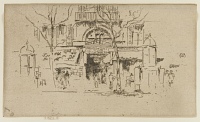Etchings Institutions search term: knoedler
Passages de l'Opéra | ||
| Number: | 386 | |
| Date: | 1888 | |
| Medium: | etching and drypoint | |
| Size: | 129 x 218 mm | |
| Signed: | butterfly at right | |
| Inscribed: | no | |
| Set/Publication: | no | |
| No. of States: | 1 | |
| Known impressions: | 6 | |
| Catalogues: | K.418; M.367; W.256 | |
| Impressions taken from this plate (6) | ||
KEYWORD
kiosks, café, balcony, passageway, picture, shop, streetscape, tree, people, vintners.
TITLE
It has always been known by the same title, except for minor mistakes or omissions in spelling, as for example:
'PASSAGES DE L'OPER[A]'' (1888, Whistler). 2
'Passage de l'Opera' (1888, Whistler). 3
'Passages de l'Opéra' (1899, Frederick Wedmore (1844-1921)). 4
The definitive title is 'Passages de l'Opéra', as used by Whistler and later cataloguers.
'PASSAGES DE L'OPER[A]'' (1888, Whistler). 2
'Passage de l'Opera' (1888, Whistler). 3
'Passages de l'Opéra' (1899, Frederick Wedmore (1844-1921)). 4
The definitive title is 'Passages de l'Opéra', as used by Whistler and later cataloguers.
2: Etched on a sign above the passage.
3: To Wunderlich and Co., 29 June 1888, GUW #13052.
4: Wedmore 1899 (cat. no. 256).
DESCRIPTION
On the pavement there are a kiosk and a bare tree on the left, and a tree and a kiosk on the right, and people walking or looking in shop windows. A row of shops, some with awnings, flank the large opening into the shadow of a busy passage in the centre. There is an arched entresol with a wrought iron railing above the entrance, and an iron railing on the long balcony on the second floor. Tall windows with louvred shutters are open on the first floor, but the ones on the second floor are nearly shut. A sign over the passageway reads: 'PASSAGES DE L'OPERA' over 'CAFE' and the illegible name of the café. A sign over the awning at the right reads: 'VINS & LIQUERS.' [sic].
SITE
The Passage de l'Opéra was one of the famous passages leading from the Boulevard des Italiens to the Opéra Peletier in Paris, France. The passage was demolished in 1925 to give way for the expansion of the Boulevard Haussmann. Where the entrance to the passage etched by Whistler once was, there is now a bank, at 16, Boulevard des Italiens. One of the advertising columns with its characteristic roof still exists.
